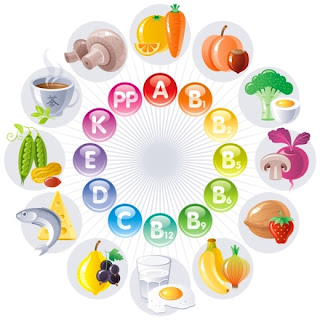Vitamins are the organic compounds that always taken from outside the body along with food in small quantity. They are required in balanced amount and are very essential to metabolism of body. Their deficiency and excess both cause metabolic disorders. The earliest known vitamin is vitamin C but earliest extracted vitamin is vitamin B1.
Classification of vitamin – On the basis of solubility, vitamins are of two types-
(A) Fat soluble vitamins- They are insoluble in water but only soluble in organic solvents like chloroform or alcohol. They are oily in nature
(B) Water soluble vitamins- They are soluble in water.
(a) Vitamin A (Retinol) or Antixeropthalmic vitamin- It is a fat soluble vitamin, exits in nature as such or in provitamin form and as carotene pigment mainly found in green pigment. This vitamin was recognized bat McCollum and Davis in1913.
This vitamin influences the growth of the body and protects from infections. Therefore, t is known as anti-infective vitamin and growth vitamin. It is also necessary for the maintenance of normal epithelial tissues of the organs including conjunctiva and cornea. Rational combines with posing protein to from rhodopsin (visual purple) of rod cells of retina. Thus it is essential for night vision.
Sources: Animal sources are fish, cod lever oil, egg yolk, butter, ghee, milk, etc. Plant sources are carotenoids (Provitamin A) found in green leafy vegetables, papaya, tomatoes, carrot, etc.
Deficiency or Avitaminosis: the deficiency of retinol causes permanent dryness of cornea of eyes called Xerophthalmia but extreme case it causes destruction of cornea called Keratomalacia. Deficiency of Vitamin A also results in the decrease of rhodopsin and thus person suffers from night blindness (Nyctalpin).
(b) Vitamin D (Calciferol) or Antirachitic Vitamin: This vitamin was also discovered by McCollum and his co-workers. Since its deficiency caused disease rickets in man, it is known as antirachitic vitamin. This vitamin plays important role in calcium phosphate metabolism. It controls the deposition of calcium and phosphorus in tissue. It is also essential for normal formation of bone and teeth.
Sources of Vitamin D: it is found in Fish liver, butter, eggs, and milk. The pro vitamin D (ergosetrol) is commonly found in plants (e.g. ergot and yeast) which are transformed into vitaminD under the influence of UV radiation in vegetables.
Deficiency of Vitamin D: Its deficiency causes rickets or rachitis in children in which proper calcification of bone does not occur. In adults, its deficiency leads to osteomalacea. It is characterized by the softening of bones specially pelvic girdles, ribs and femur leading to deformities in the body posture. (
(c) Vitamin E (Tocopherol ): This vitamin was discovered by Evans and Sure in 1922. This vitamin is also now as antisterilitic factor or beauty vitamin because it prevents sterility in females and maintains the normal health of the sex organs and ensures the normal condition.
Sources of Vitamin E: It is usually found in vegetable seed oils, corn oil and oil of wheat grains and green leafy vegetables.
Deficiency: Deficiency of vitamin E causes reversible sterility in females which is characterized by ovulation, fertilization and implantation but foetus resorbed in the uterus after sometime. In male its deficiency causes destruction of germinal epithelium of testes and thus failure to produce spermatozoa resulting sterility.
Vitamin K (Antihaemorrhagic) or Phylloquinone: This vitamin is necessary for the formation of Prothrombin in liver which participates in blood clotting. Dam 1934 discovered and named this vitamin K from the term koagulation it is available in two forms- K1 and K2. Both are the derivatives of naphthaquinone.
Sources: It is mainly available in vegetable sources like green leafy vegetables like, sunflower, spinach, etc. it is rich in animal sources like, liver, egg yolk, etc. it is also synthesized d by symbiotic bacteria of intestine (colon)
Deficiency: Deficiency of vitamin causes failure of blood clotting called hypoprothrombinaemia even after minor injuries resulting into profuse bleeding that is called haemorrhage.
VITAMINS and their characteristics
VITAMINS and their characteristics

No comments:
Post a Comment